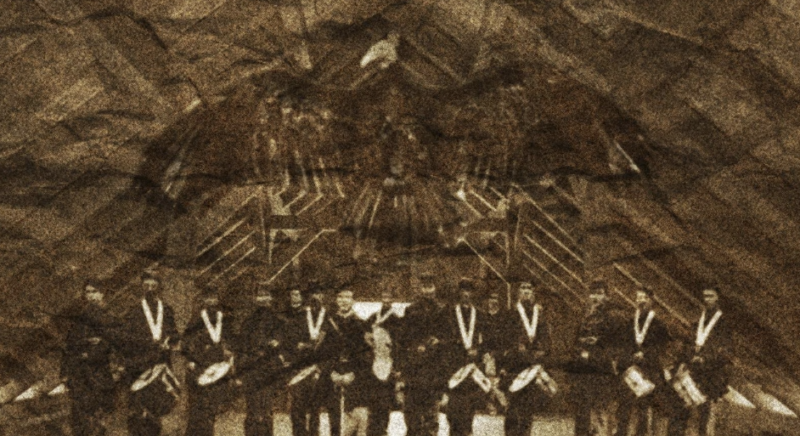The Tombstone Thunderbird Photograph and the Mandela Effect
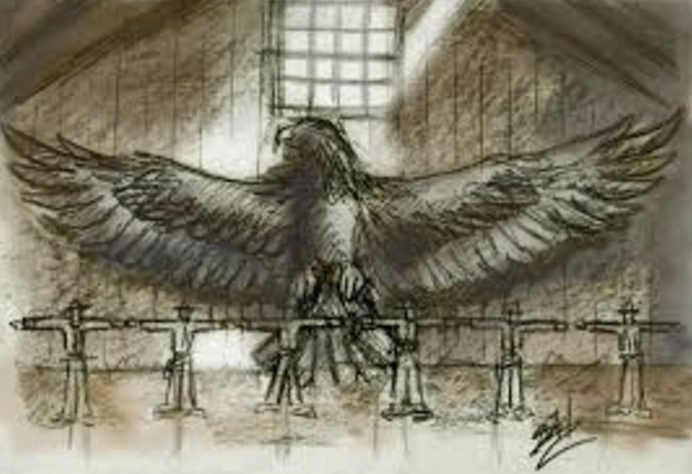
The Mandela Effect: false memories shared by multiple people, often complete strangers.
Paranormal researcher Fiona Broome coined the term in 2010 after recording her own false memory of South African President Nelson Mandela. According to Broome, she had a distinct memory of Mandela dying in prison during the 1980s – she even remembered watching the funeral broadcasted on international television. But in reality, Mandela was still very much alive and didn’t pass away until 2013. And while humans miss-remember things all the time, Broome felt her false memory of Mandela was particularly strange because she wasn’t the only person that remembered it that way. When Broome posted her research online, countless people came forward to share the that they too thought Mandela had died in the 80s and that they also recalled watching his funeral on television.
The more the Mandela Effect was discussed, the more occurrences of shared false memories were uncovered. Countless examples have popped up since 2010 and some conspiracy-minded folk have speculated if something fishy is going on with our current timeline… but more on that later.
For those out of the loop, here are a few popular examples of the Mandela Effect:
- When quoting Hannibal Lector in Silence of the Lambs, people often say “Hello, Clarice.” However, the real line Hannibal Lector uses to greet Clarice is simply “Good morning.”
- The popular children’s book series about a family of bears was actually called The Berenstain Bears, not The Berenstein Bears as many people (including myself) seem to remember incorrectly.
- The popular shoe brand is called Skechers, not Sketchers.
- In the timeless sitcom I Love Lucy, Ricky Ricardo’s most famous line is often remembered as “Lucy, you have some ‘splaining to do”, but in reality he only ever said the lines “Splain that if you can” and “Lucy, ‘splain”.
You get the idea. A large majority of examples of Mandela the Effect come from popular culture, with a few examples (like the Mandela Effects namesake) focusing on a historical event. This is where the Tombstone Thunderbird comes in.
The Tombstone Thunderbird

The story of the Tombstone Thunderbird is a good ol’fashioned tale straight from the Wild West. But instead of ‘Cowboys vs “Indians”‘ its cowboys vs a mysterious prehistoric monster.
The town of Tombstone, located in Cochise Country, Arizona was founded in 1879 by prospector Ed Schieffelin who scoured the area for ore samples before stumbling upon silver in the Goose Flats. Ed established the new town near the silver mine and named it ‘Tombstone’ as a humorous nod to the countless times he was warned that all he would find wandering around the desert was his own tombstone. Ed had the last laugh as Tombstone quickly became one of the richest mining towns in the Southwest.
Tombstone was everything the modern mind conjures up when thinking of the Old West. They even had an old-fashioned shootout in 1881 between officers and cowboys that left three men dead — you can’t get anymore Wild West than that! But while the gunfight at the O.K. Coral became one of the most infamous shootouts of Wild West history, it dulls in comparison to another Tombstone story about two ranchers that allegedly found a giant flying monster out in the desert.
The story of the Tombstone Thunderbird began on the 26 April 1890 when the following was printed in the local paper The Tombstone Epitaph:

A winged-monster, resembling a huge alligator with an extremely elongated tail and an immense pair of wings, was found on the desert between the Whetstone and Huachuca mountains last Sunday by two ranchers who were returning home from the Huachucas. The creature was evidently greatly exhausted by a long flight and when discovered was able to fly but a short distance at a time.
After the first shock of wild amaze-ment had passed the two men, who were on horseback and armed with Winchester rifles, regained sufficient courage to pursue the monster and after an exciting chase of several miles succeeded in getting near enough to open fire with their rifles and wounding it. The creature then turned on the men, but owing to it’s exhausted condition they were able to keep out of its way and after a few well directed shots the monster partly rolled over and remained motionless.
The men cautiously approached, their horses snorting with terror, and found that the creature was dead. They then proceeded to make an examination and found that it measured about ninety-two feet in length and the greatest diameter was about fifty inches. The monster had only two feet, these being situated in a short distance in front of where the wings were joined to the body. The head, as near as they could judge, was about eight feet long, the jaws being thickly set with strong, sharp teeth. It’s eyes were as large as a dinner plate and protruded about half way from the head. They had some difficulty in measuring the wings as they were partly folded under the body, but finally got one straightened out sufficiently to get a measurement of seventy-eight feet, making the total length from tip to tip about 160 feet. The wings were composed of a thick and nearly transparent membrane and were devoid of feathers or hair, as was the entire body. The skin of the body was comparatively smooth and easily penetrated by a bullet.
The men cut off a small portion of the top of one wing and took it home with them. Late last night one of them arrived in this city for supplies and to make the necessary preparation to skin the creature, when the hide will be sent for examination by the eminent scientists of the day. The finder returned early this morning accompanied by several prominent men who will endeavor to bring the strange creature to this city before it is mutilated.
Tombstone epitaph., 26 April 1890 via the Library of Congress
There was never a follow-up article, so whether or not the creature was brought back to Tombstone was never verified. Was the article sensationalised? Most likely. Though its uncertain if it’s the reporter that’s pulling their readers’ leg or if the two ranchers made a bet to frighten Tombstone into thinking prehistoric beasts were lurking on their borders. There’s also the miniscule possibility that this actually happened, though much less dramatically than it was written. Regardless, the mysterious flying creature was christened the Tombstone Thunderbird and would become a real pain in the neck for cryptozoologists and amateur enthusiasts during the second half of the twentieth-century. And it’s all because of one very elusive (and possibly non-existent) photograph.
The Mystery of the Thunderbird Photograph
A lot of people (admittedly, myself included prior to researching this article) are certain they’ve seen a photograph of the Thunderbird from the day the ranchers brought it to Tombstone. Usually they’ll recall some variation of the following: a photograph showing the Thunderbird (deceased) with it’s giant wings held up by the men that shot it down while standing in front of an old barn wall. Sometimes the photograph is remembered showing the Thunderbird pinned up, crucifixion style on the side of the barn while a line of men stood in front with their arms outstretched to represent the size of the wingspan. This is the version I personally thought I’d seen before. The photograph at the beginning of this article is a typical representation of what many believe the photograph looked like.
Those of us with a lifelong interest in cryptozoology seem to recall seeing the photograph in a book on unexplained mysteries, or on a televised documentary in the dark days before the internet. I personally remember seeing the photograph in the ‘unexplained world mysteries’ section of an illustrated encyclopaedia I had as a kid — squished between the Shroud of Turin and an alleged photo of the Roswell alien. But despite our best efforts, no one has managed to track the silly thing down.
And when someone becomes disillusioned into thinking they’ve ‘solved’ the case of the missing photograph, they usually end up sharing one of these:
But unfortunately, they’re all fake. And there are dozens of equally fake photos scattered around the internet.
Many believe the original photograph was printed in the Tombstone Epitaph alongside the article (transcribed above) in 1890. However, at that time the Tombstone Epitaph was not technologically capable of publishing photos in their newspaper. This rumour has officially been put to rest since the original article is now available to view online through the Library of Congress website. And it’s clear that the article, and the entire 26 April 1890 issue of the newspaper, didn’t include any photographs.

Unless there is some big conspiracy to erase visual evidence of the Tombstone Thunderbird from history, it’s pretty clear that the photograph was never printed in the newspaper. In 1960 the Tombstone Epitaph staff themselves checked their archives and confirmed that no photo ever existed. So what’s going on?
Why are we all so convinced the photograph exists?
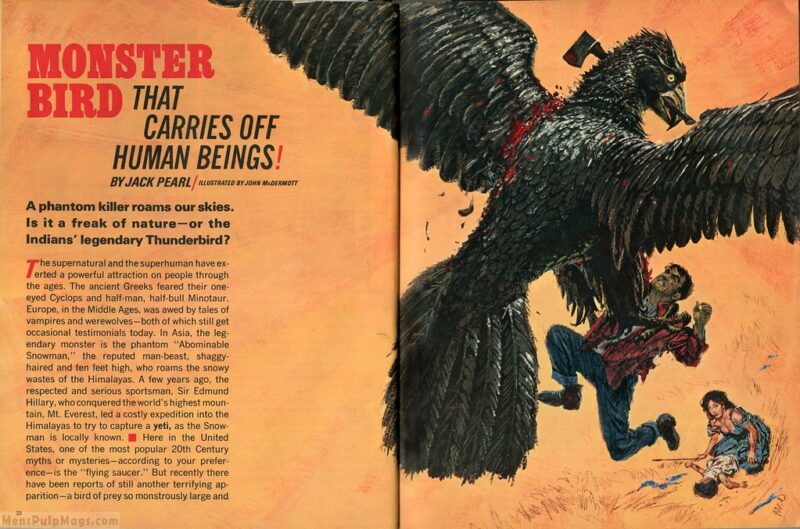
The misunderstanding can be traced back to Harlequin romance novelist Jacques Brian Pearl (1923-1992) who wrote an article on the Thunderbird under the pseudonym Jack Pearl for the May 1963 issue of the men’s adventure magazine Saga. Titled ‘Monster Bird That Carries Off Human Beings!“, the dramatic tale mixes fiction and a sprinkle of real history while retelling the story of the Tombstone Thunderbird. Pushing the date of the original encounter from 1890 back to 1886, Pearl’s version of the story is said to be even more outrageous than the original Tombstone Epitaph report. For instance, the Saga article claims there was a second Thunderbird at the scene that grabbed a man in it’s talons and flew up into the sky.
Pearl’s article is relevant to our purposes since it appears to be the first time a photograph of the Thunderbird was mentioned being published in the Tombstone Epitaph. He describes the photograph as showing the Thunderbird nailed to a barn with it’s wings spread wide while ten men stand in front of it for scale. Sound familiar?
After Pearl’s article was published, the existence of the alleged photograph slowly became embedded in the story of the Thunderbird until this fragment of the fictional tale was considered truth. A lot of us remember the exact photograph that Pearl described in his article, not because we read the article ourselves, but because the existence of a photograph of the Tombstone Thunderbird was casually repeated and written on so many times that we subconsciously accepted that it was real.
Memories work in mysterious ways, which brings us back to the Mandela Effect.
What causes the Mandela Effect?

Some believe the Mandela Effect is proof that there are multiple timelines or parallel realities. This would imply that while the Thunderbird Photo doesn’t exist in our current timeline, it does exist in another.
However, the actual reason is less based in science fiction and more in our current understanding of the unreliability of our memories. Wherever we read about the Thunderbird photograph, likely in a time before the internet, made enough of an impression on us that we accepted the information without question, and then likely forgot about it completely. Then when we heard the Thunderbird mentioned again years later we instantly thought ‘I remember seeing a photograph of that as a kid!’. Or maybe we did see a version of the Thunderbird photograph, but it was one of the hoax photos that have been floating around for years and years. All it takes is one person on an internet forum bringing up the photograph for everyone who read about it years earlier to start a wild goose chase for something that never existed to begin with.
The Tombstone Thunderbird photograph is an interesting example of the Mandela Effect because, as seen above, we have a pretty good idea of where this false-memory came from. A lot of the time shared false memories (as seen in the examples listed at the beginning of this article) come from an unknown/undetermined source and are repeated so often that they become a shared ‘truth’ without anyone realising that it is, in fact, false. Movie quotes are the best example of this since they become so ingrained in pop culture that even the most well-known ones get muddled over time. For instance, in the film The Empire Strikes Back Darth Vader never says “Luke, I am your father.” but he does say “No, I am your father.” We’ve all seem The Empire Strikes Back. We all know this scene. And yet most of us would probably misquote it if asked.
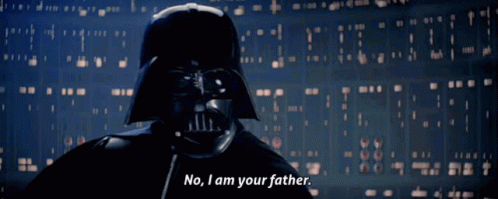
An article published in Discovery Magazine in 2017 titled ‘Collective False Memories: What’s Behind the ‘Mandela Effect’?‘ breaks down the science behind false memories and explains why we’re so certain we remember something that never actually happened. According to the article some driving forces behind the Mandela Effect can include confabulation, which is the brain’s attempt at filling in memory gaps by inserting information and experiences that aren’t real, and suggestibility, which is our natural inclination to see truth in information implied by another individual.
So are we the victims of mind control? A government conspiracy? A glitch in the Matrix? As fun as it might be to hypothesised a more fantastic reason behind the Mandela Effects, it’s really just a good example of how untrustworthy and easily manipulated our memories can be, even unintentionally. There’s a reason eyewitness testimonies aren’t necessarily considered reliable. Memories are too easily distorted.
As for the Tombstone Thunderbird photograph, I think it’s safe to say that the photo never existed and we were all indirectly victims of Jack Pearl’s sensational tale from 1963 (but I won’t judge you for wanting to believe otherwise).
And by the way — the town of Tombstone still exists and is open to tourists keen to explore ‘the most authentic western town left in the United States’! If you get the chance to visit make sure to keep your camera pointed to the sky in case another Thunderbird appears. Who knows, maybe in 100 years people will be arguing over whether or not a photo you took ever actually existed.
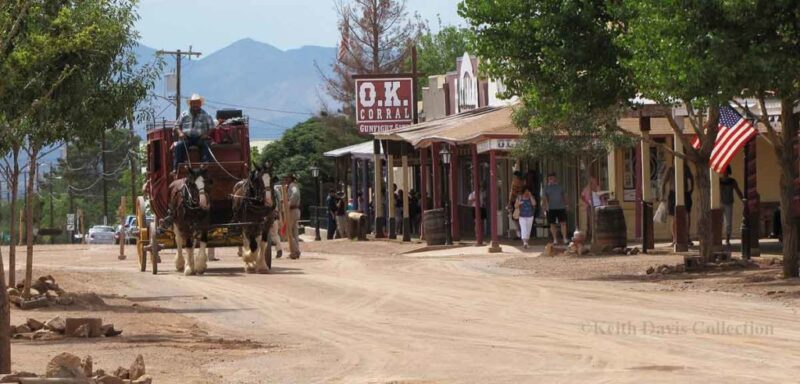
Sources and Additional Reading
Caterine, Darryl and John W. Morehead. The Paranormal and Popular Culture: A Postmodern Religious Landscape. 2019.
Discovery Magazine – Collective False Memories: What’s Behind the ‘Mandela Effect’?
Parade – 50 Mandela Effects of Things You *Think* You Remember Correctly (That You’ve Actually Got All Wrong)
Strange Magazine – Unravelling the Mystery of the Thunderbird Photograph
The MothMan Wikia – The Missing Thunderbird Photo
Tombstone Web – History
True West Magazine – Tombstone’s Flying Monster
True West Magazine – Tombstone Thunderbird




